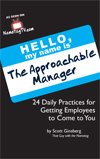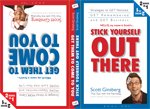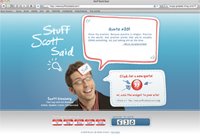 “Nobody ever comes up to me…”
“Nobody ever comes up to me…”
“Nobody ever asks me any questions…”
“What’s WRONG with these people…?”
POSSIBLE ANSWER: Nothing.
Maybe it’s YOU.
Maybe the reason nobody ever asks you any questions is because you’re NOT perceived as an Askable Person.
Whoa. There’s a counterintuitive thought. Being Askable. Huh.
SO, HERE’S THE SECRET: Forget about “getting” people to ask questions.
Instead, identify and embody the attributes of Askable People, and the rest will fall into place.
Whether you’re a manager, executive, teacher, counselor, parent – or hold any other type of leadership position (ahem, that’s ALL of us) – your approachability is a function of your ASK-ability.
Today we’re going to explore a list of 29 Ways to Build a Reputation as an Askable Person:
1. Acceptance. Recognize that someone has an opinion, even though it may not be your own. You don’t have to agree. You don’t have to disagree. Just honor it. Honor = Respect = Trust = Willingness to Ask More Questions.
Otherwise you’ll start to resemble Dilbert’s Pointed Haired Boss, whose management mantra is, “I’m not going to comment – I’ll just look at you until you agree with me.” What is your ego having a hard time accepting?
2. Acknowledge the discomfort. That’s where the difficulty comes from. That’s why people are hesitant to approach you: The topic makes them feel uncomfortable. You need to saddle up on that white elephant and move on. Remember: No Conflict = No Avoidance. What immediate preoccupation do you need to disarm?
3. Assuming blocks openness. She’s too young to talk about this … He’s too old to address this issue … They’re not ready to deal with this yet … Really? According to whom? Your ego? Your insecurity? Google?
Look. Stop justifying. That attitude will seep into your words and actions and, as a result, people won’t want to approach you with their questions. What lies are your assumptions guarding?
4. Be wrong more. Frequent wrongness demonstrates vulnerability, honesty and humanity. That’s the kind person you want to ask questions to because, similar to yourself, he doesn’t have all the answers. When was the last time you said, “I don’t know”?
5. Beware of Emotional Reactivity. The word “emotion” comes from the Latin emotere, which means “disturbance.” Which actually makes sense. See, emotional reactivity is contagious, undermines trust, blocks understanding, creates defensiveness and prevents questions from being asked. Yikes.
Here’s the secret: Next time you get a question that might normally drive you crazy, pause. Take a deep breath before responding. (In through your nose for five seconds – pause – out through your nose for five seconds.) This lowers your heart rate, oxygenates your blood and prevents the activation of the flight/fight response. Otherwise, your reflexive interruptions will fuel the emotional fire. Works in yoga, works in business. How’s your breathing?
6. Body cancels mouth. People don’t just learn from what you say, but how you BEHAVE and react to situations. That’s why it’s easier to tell the truth. Because your body might rat you out. What do people hear when they listen to what you do?
7. Create a Question Friendly Environment (QFE.) A safe space. A non-threatening atmosphere where people (1) feel comfortable, and (2) feel like they have permission to ask anything that’s on their minds. I don’t have the space to write more than that, so here’s a more detailed examination on creating a question friendly environment. How do you define the atmosphere needed to ask an answer people questions successfully?
8. Dig deeper. If you can tell that someone HAS a question, but isn’t asking, trying asking yourself: What is behind their reluctance?
Maybe they don’t want to look stupid.
Maybe they think it’s the wrong time to ask.
Maybe they think the answer will be threatening.
Maybe they think their questions aren’t good questions.
Maybe they fear making a big mess and getting in trouble.
Maybe they were ridiculed when they questioned in the past.
Maybe they haven’t discovered a safe place to be vulnerable.
Maybe they don’t want to hold up the discussion/meeting/class.
Maybe they don’t want to appear in need of help or risk ridicule and rejection.
The list goes on and on. Make one for your own leadership situation. I triple dog dare you. Why might your people NOT ask questions?
9. Do your research. Being informed gives you confidence and, therefore, lowers your level of discomfort in an interaction. And, because emotions are contagious, this lowers the other person’s level of discomfort as well.
My suggestion: Make a list called, “101 Questions My (x) Will Probably Ask Me.” (The “x” in that equation stands for your peeps, i.e., students, employees, children.) How much time do you spend preparing to listen?
10. Don’t act embarrassed. If someone asks you a question about a potentially uncomfortable topic (sex usually does the trick) don’t try to diffuse the discomfort by making a joke out of it. That tactic only works in reverse and makes the conversation more uncomfortable.
Instead, work on your poker face. Honor their question despite the fact that you might be giggle like a little schoolgirl on the inside. This form of openness will show the Asker that it’s both acceptable and comfortable to discuss such issues. Does your immature reaction to a word like “penis” prevent people from EVER asking you another question again?
11. Don’t ask, “Why do you want to know?” First of all, never begin a question with the word why. It immediately puts people on the defensive and forces them to justify their question.
Secondly, the motivation behind the question isn’t as important as your willingness to open a dialogue about the question. Third, if you’re respectful, accepting and understanding, don’t worry. The “why” be revealed to you at the right time. What words govern your questions?
12. Don’t be too busy to explain. This communicates two messages to the other person: (1) My time is more valuable than yours, and (2) Your question is not important.
Suggestion: Stop whatever you’re doing and give yourself fully to the other person. Or, if they catch you off guard, book “blank time” in your schedule. How many important conversations does your busyness prevent from ever occurring?
13. Don’t dodge difficult issues. Similar to your ability to handle good news/bad news and positive/negative feedback, also practice handling easy/difficult issues. Both are equally important and require your attention.
Even if you don’t have an answer, by responding with early intervention, you solve small problems before they snowball into big problems. This also proves to the other person that every difficult situation is NOT a crisis.What questions are your people afraid to ask you?
14. Don’t laugh. In almost every episode of The Office, Michael Scott will respond to crazy questions by laughing hysterically or degrading The Asker. This instantly shuts down the communication channel and destroys the desire for future encounters. Plus it makes you want to reach through the television and strangle him.
Similar to “embarrassing” questions, also learn to hold your poker face when you’re asked a question that’s completely illogical. Treat all questions with deep democracy. And don’t laugh at irrational inquiries. Even when you’re convinced the person should be locked up in a mattress-lined cell. Why are you laughing?
15. Don’t pretend you don’t know. First of all, people can tell. You’re not that good of a liar. Secondly, skirting the issue only makes people more reluctant to ask questions in the future.
Thirdly, bad advice and/or failure to communicate leads to uninformed choices, which leads to more work for you down the line. Try saying, “I don’t know, but I can find out…” or “Let’s go google that together.” Are willing to expose your ignorance?
16. Don’t just start answering non-stop. That’s a reaction, or a reflex. You need to respond, which is a choice. Make sure you’re only talking about 30% of the time. Seek to monopolize the listening.
Here’s a good test: If the other person finishes their meal before you, you weren’t listening enough. Or they eat too fast. Are you answering or vomiting?
17. Four words: “I told you so.” This sentence – or any permutation thereof – discontinues communication and makes people start wondering why they even bothered to ask you. Look. People don’t need to be reminded how badly they screwed up.
They need to be reassured that you’re going to (1) love them when they DO screw up, (2) help them prevent the same mistake from being made again, and (3) partner with them to brainstorm lessons learned from those mistakes. Are you giving people permission to fail?
18. Give Askable Reminders. Make it a point to tell people (employees, customer, kids, whomever) that you’re available if they have any questions or problems – no matter how tough they may be.
It’s unwise to assume people feel comfortable seeking you out on the difficult issues. Good verbiage: “What questions do you have?” versus “Do you have any questions.” How are you reinforcing your askablity?
19. Give yourself permission to feel uncomfortable. So, it’s a touchy subject – fine. Deal with it. You never learn when you’re comfortable anyway.
My suggestion: Channel that discomfort into your breathing or your enthusiasm for the person who asked the question. Don’t try to conceal it, or it will find a home somewhere in your body. Are you willing to stick yourself out there?
20. Go deeper anyway. Be willing to keep talking until they’re satisfied with your answer. Let what you say have an impact on them. Patiently let the pearl sink. Allow your words to profoundly penetrate them. This practice respects their speed of discovery and encourages them to come back to you with question in the future.
On the other hand, if you explain something too quickly – via your head, not your heart – the other person’s level of understanding will resemble the digestive ability of Cookie Monster: All chewing, no swallowing. (Ever notice how he never actually eats any of those cookies? Weird.) How are you speaking to people where they are?
21. Lay a foundation of affirmation. If you want people to come to you and come BACK to you with their questions, respect and trust MUST come first. Here’s why. Acknowledgement is a universal human need. So, listening is initially about affirmation. Making people feel (not just) valued, validated and important; but ESSENTIAL.
Suggestion: Always prime your responses with, “Great question!” or “Wow, that’s a very intelligent question.” Make the question-asker feel smart for asking, no matter what the question. How early are you complimenting people?
22. Lectures lose people. When someone asks you a question, remember these tenets: No advice. No fixing. No platitudes. No “shoulds.” Just cut to the chase. Just give people the meat. Speak to self-interest with meaningful concrete immediacy. Otherwise you’ll make the person instantly regret approaching you with a question and therefore less likely to do re-approach the future.
Here’s the secret: Back and forth. Like a ping-pong match. An answer here, an answer there. Share values without preaching. Establish gentle flow. Remember: If they don’t come to you, they will seek answers elsewhere. Possibly from total idiots, or, worse yet, The Internet. Oh boy. Anyone? Anyone? Bueller? Bueller?
23. Practice receiving good AND bad news equally. Otherwise you will scare people. And they’ll assume the only time they can ever approach you is when their ideas are positive.
As such, your unapproachable appearance will stop question asking in its tracks. Are you willing to suspend your judgment and evaluation of what people tell you until you’ve taken adequate time to process their information?
24. Respect confidentiality. Let them know the question is between the two of you. Or, if anonymity is optional, allow people to write their questions on index cards and turn them in. This enables shy people to honesty speak up because their name isn’t on the line. Do people trust you NOT to be a blabbermouth?
25. Seek extreme clarity. Ask people to clarify their question EVEN when you think you understand. Then, wait until you fully understand the question fully before you answer. Don’t view other people’s speech as a tedious interruption of your ideas.
Remember: You rarely hear people complain, “Damn it! I wish you wouldn’t have been so clear in your answer!” How is what you (think) you know thwarting what you need to hear?
26. Turn the table. Consider how YOU would feel asking such question. Or, think about how you DID feel when you asked that same question. Go back in time. Awareness of your own attitudes, values and tendencies is necessary before you can effectively communicate with others. How can your past make you more Askable?
27. Unconditional positive regard. If you log on to the very cool parenting website, www.advocatesforyouth.com, you’ll find a helpful piece on being an Askable Parent. It suggests following:
“Don’t withdraw love or support if what is asked is inappropriate or disappointing.”
Now, even if you’re not a parent, the lesson is still applicable: Love people anyway. There’s no such thing as a stupid question, only stupid people who don’t ALLOW questions. (Thanks to Carl Rogers for this one!) What types of questions piss you off?
28. Validate their feelings. Never say, “You don’t really feel that way.” Everyone is entitled to whatever feelings arise. You need to honor whatever surfaces. It’s like in A League of Their Own when manager Tom Hanks yells, “Are you crying? There’s no crying! There’s no crying in baseball!”
Wrong response. Tell people they perfectly deserve to feel the way they do. This is another way to lay a foundation of affirmation. What feelings are you not allowing people to have?
29. Welcome criticism and praise equally. Learn to respond to positive AND negative questions in a supportive, helpful and non-emotionally reactive way. Otherwise people either (1) only ask easy, positive questions, or (2) not ask any questions at all. How open are you to questions that reveal your screw-ups?
REMEMBER: The reason people aren’t coming up to ask you questions (might) have nothing to do with them.
It might have more to do with your Askability. Or lack thereof.
Forget about “getting” people to ask questions. Instead, I challenge you to identify and embody the attributes of Askable People, and let the rest follow suit.
Any questions on that?
LET ME ASK YA THIS…
Are you an Askable Person?
LET ME SUGGEST THIS…
For the list called, “37 Personal Leadership Questions Guaranteed to Shake Your Soul,” send an email to me, and I’ll send you the list for free!
* * * *
Scott Ginsberg
That Guy with the Nametag
Author, Speaker, Coach, Entrepreneur
[email protected]
 If they can’t come UP to you; how will they ever get BEHIND you?
If they can’t come UP to you; how will they ever get BEHIND you?
Buy Scott’s new book and learn daily practices for becoming a more approachable manager!
Pick up your copy (or a case!) right here.

 1. Bathtubbing. That means writing and writing and writing until you get something good. Letting the shanks, the crap, the not-so-good material come out first and swirl into the drain. This allows you to release it without committing to keeping it.
1. Bathtubbing. That means writing and writing and writing until you get something good. Letting the shanks, the crap, the not-so-good material come out first and swirl into the drain. This allows you to release it without committing to keeping it. 
 The world’s FIRST two-in-one, flip-flop book!
The world’s FIRST two-in-one, flip-flop book! “I feel like we could talk forever!”
“I feel like we could talk forever!”

 1. Be not alarmed when you discover that nobody cares about you.
1. Be not alarmed when you discover that nobody cares about you. 1. Be silently attentive. You need to be the kindergartner during story time that doesn’t fidget, play or pick his nose. You need to be the well-behaved dog with a tilted head, a wagging tail and a look of “
1. Be silently attentive. You need to be the kindergartner during story time that doesn’t fidget, play or pick his nose. You need to be the well-behaved dog with a tilted head, a wagging tail and a look of “ Today we’re going to continue exploring practices to help you become known as the most approachable person in your organization. (If you haven’t read Part 1 of this series, you can do so
Today we’re going to continue exploring practices to help you become known as the most approachable person in your organization. (If you haven’t read Part 1 of this series, you can do so  Who’s quoting YOU?
Who’s quoting YOU? How many blog posts did you write last month?
How many blog posts did you write last month? Who’s quoting YOU?
Who’s quoting YOU?